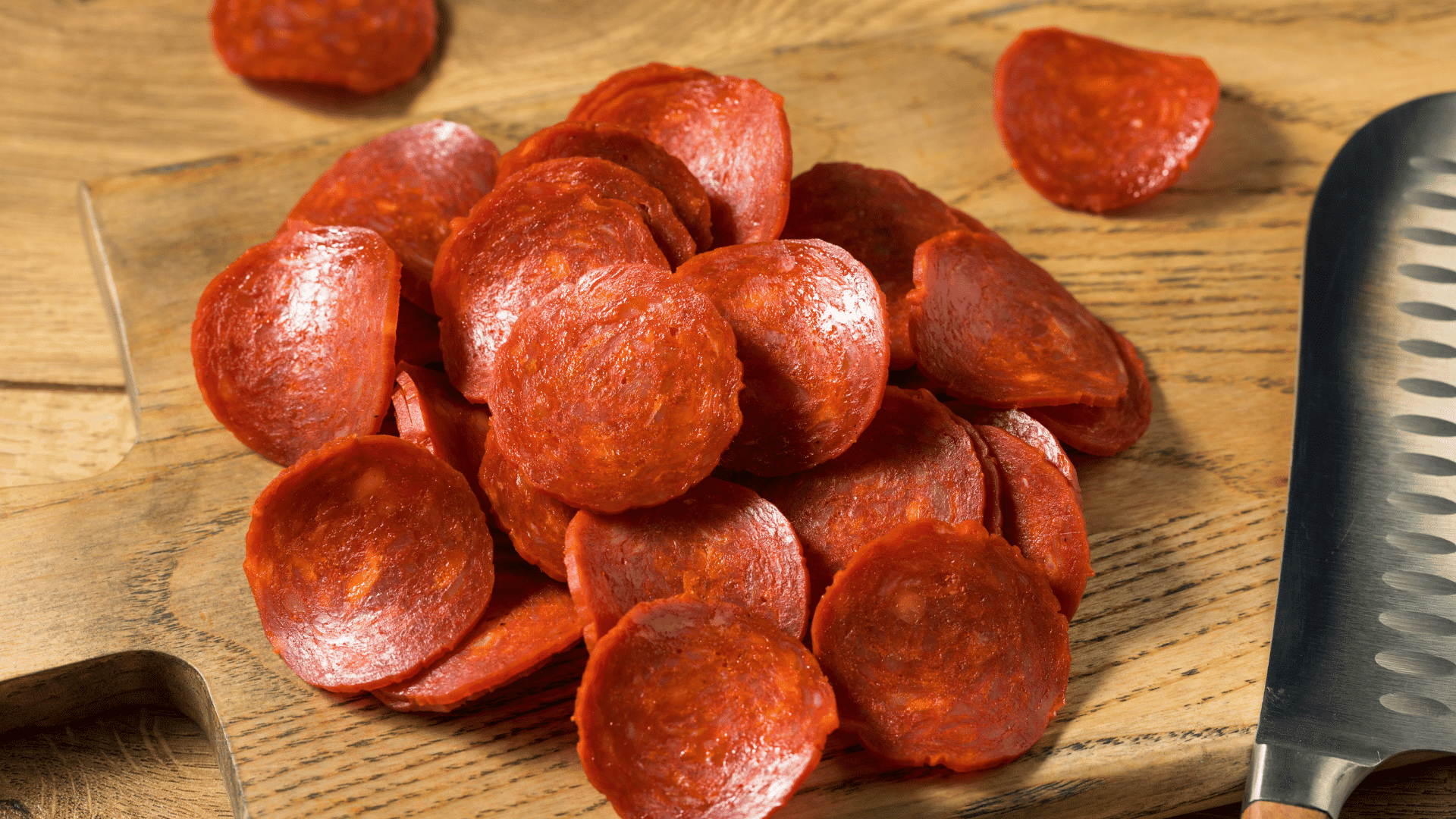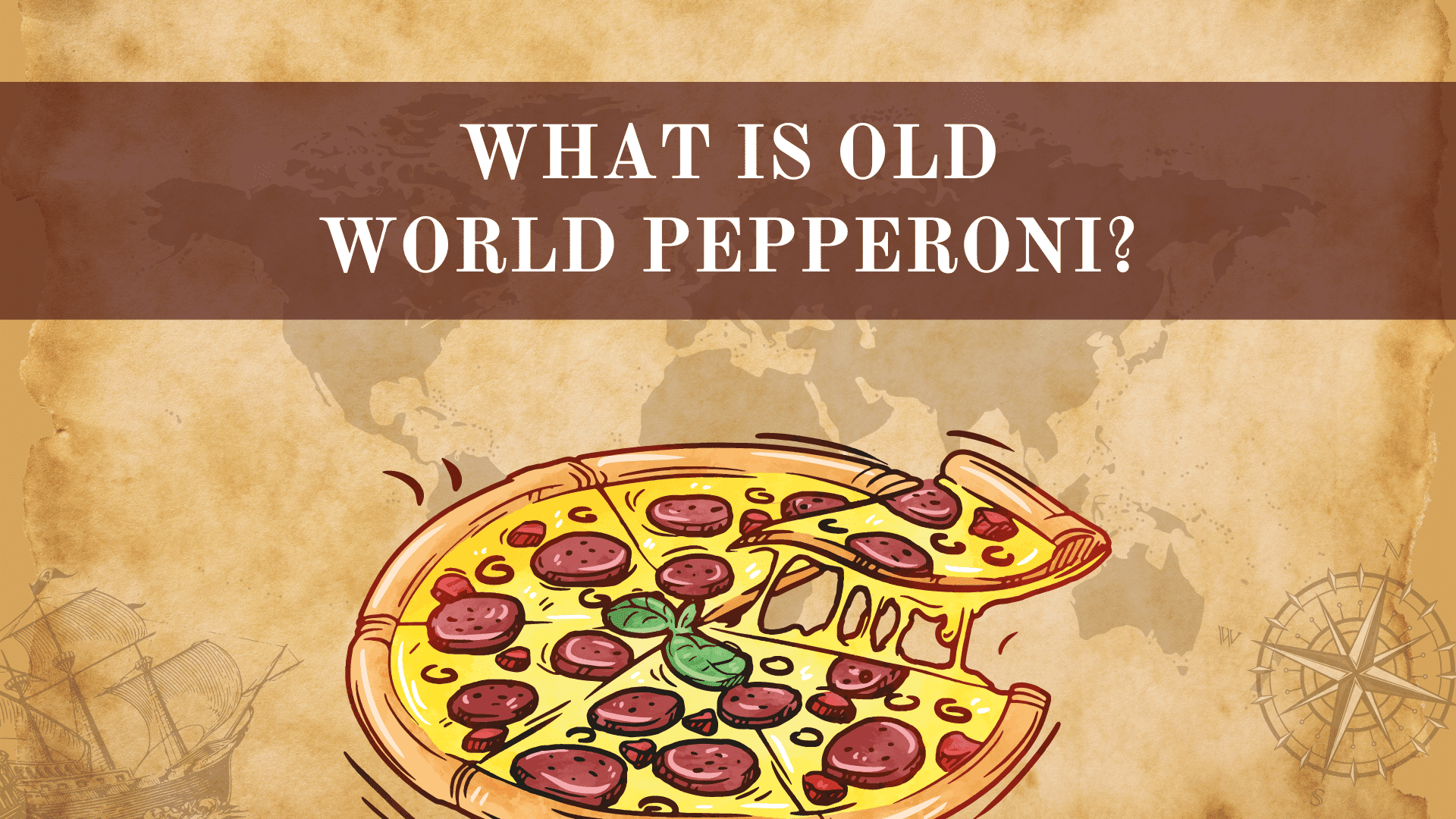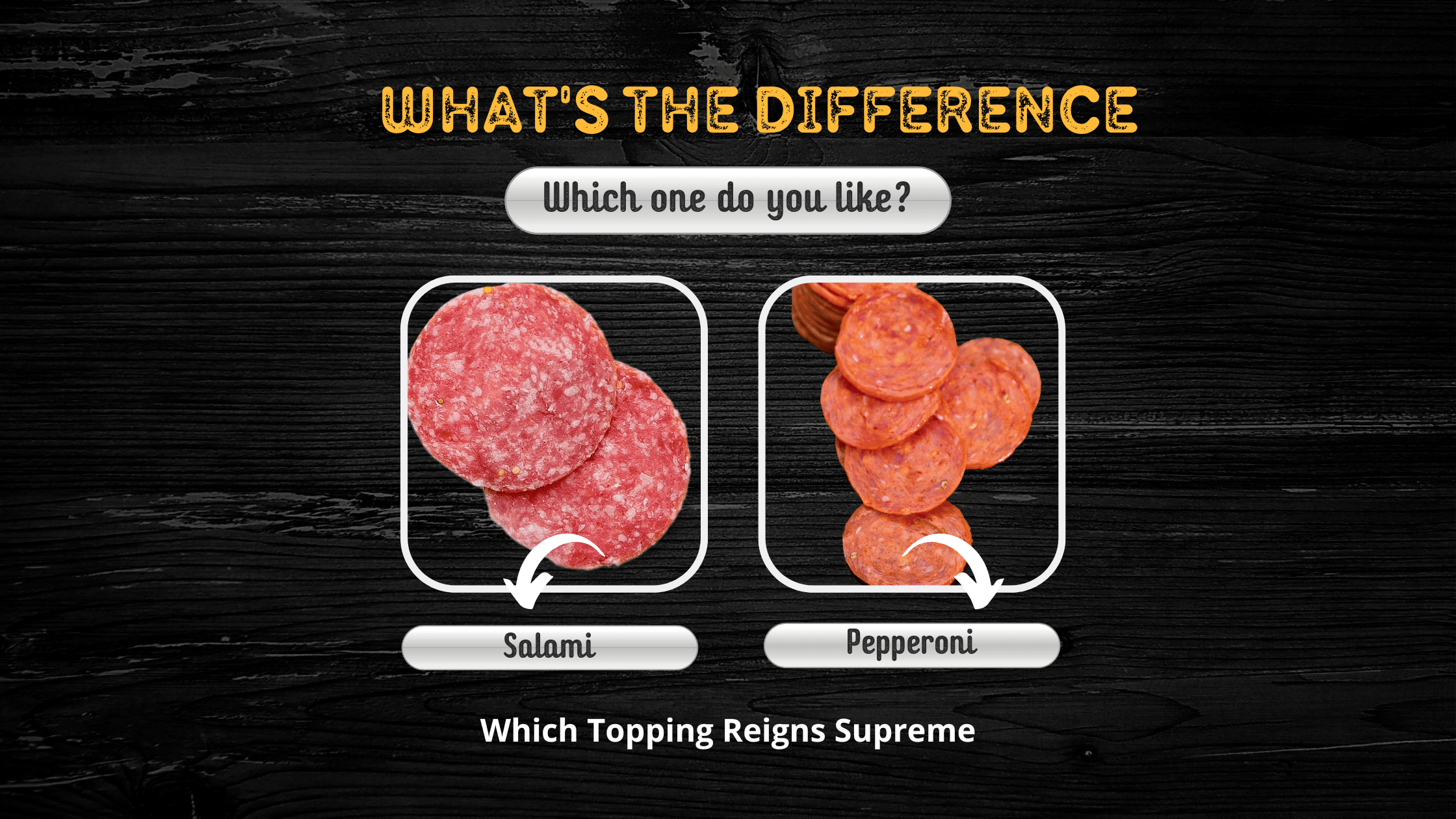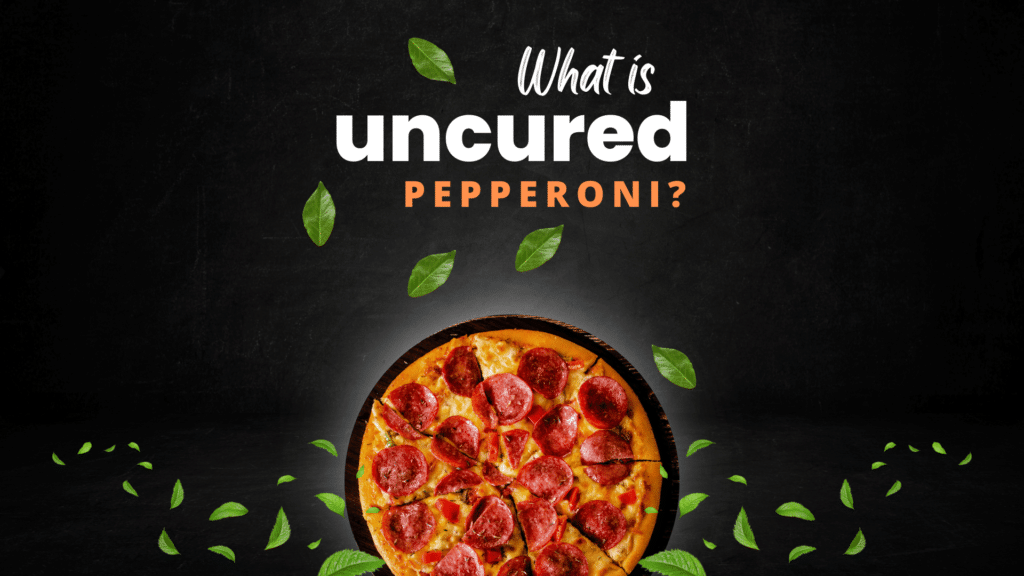Editor’s Note: This article received its latest update on March 6, 2024, ensuring you have access to the most current information and the newest trends in the pizza world.
Are you curious to know what is uncured pepperoni and how it can transform your pizza experience? Have you ever wondered about the difference between cured and uncured pepperoni, especially when topping your favorite slice?
This article promises to unveil the intricacies of uncured pepperoni, offering insights into its preparation, flavor profile, and health advantages.
Perfect for pizza enthusiasts looking to refine their palate and those mindful of their dietary choices, we’ll guide you through the benefits and distinctive taste that uncured pepperoni brings to the table.
Continue reading to discover why uncured pepperoni might just be the game-changer for your pizza night.
Let’s get started!
Here’s What You Will Find:
What is Uncured Pepperoni?
Uncured pepperoni is a type of pepperoni that has not undergone the traditional curing process involving synthetic nitrates or nitrites. Instead, it is made with natural curing agents found in celery powder or sea salt containing naturally occurring nitrates.
These compounds are converted into nitrites by bacteria, which then act as a preservative and color fixative, much like synthetic nitrites do in cured meats.
The main difference between cured and uncured pepperoni lies in the source of the nitrates/nitrites.

Natural curing agents allow uncured pepperoni to be labeled as “no nitrates or nitrites added,” except for those naturally occurring in the ingredients used. This can appeal to consumers looking for products with more natural or wholesome ingredients.
Despite the “uncured” label, uncured pepperoni is still cured through a process that adheres to the USDA’s requirements for being labeled as such. It undergoes fermentation or is treated with a lactic acid starter culture to develop its flavor and ensure safety by inhibiting the growth of harmful bacteria.
In terms of taste and appearance, uncured pepperoni can be very similar to traditionally cured pepperoni, offering the same spicy, tangy flavor profile and red color that pepperoni is known for. However, some people might notice a slightly different taste due to natural curing and the absence of synthetic chemicals.
Choosing uncured pepperoni is often a matter of personal preference, influenced by an interest in natural food processing methods and ingredient sourcing.
Pepperoni is a beloved food item, popularly known for its starring role on pizzas around the globe. It’s a variety of salami, an Italian-American creation, made from a blend of cured pork and beef seasoned with paprika and other chili peppers. This well-known meat is cured and preserved through various salts and nitrates, enhancing its characteristic flavor.
On the other hand, food consumption has witnessed a substantial shift in recent years, with a growing focus on healthier, more natural choices. This has led to the emergence of ‘uncured’ meats, which, despite the name, are also preserved but with methods aimed at avoiding certain additives, particularly synthetic nitrates and nitrites.
Like traditional pepperoni, uncured pepperoni is made from beef and pork. The meats are finely ground, mixed with a carefully chosen blend of spices, and then stuffed into casings.
However, instead of adding synthetic sodium nitrite, the meat mixture is combined with a natural source of nitrates/nitrites. These compounds react with certain bacteria in the meat, converting the natural nitrates into nitrites, which then cure the meat.
Uncured Pepperoni Flavor
Compared to traditional, cured pepperoni, uncured pepperoni offers a slightly different flavor profile and texture due to the absence of synthetic nitrites and the presence of natural curing agents. The taste is often described as more natural or less tangy than cured pepperoni.
Moreover, uncured pepperoni tends to be slightly less red than cured versions because natural nitrites do not color the meat as intensely as synthetic ones.
The popularity of uncured pepperoni has grown in recent years due to a consumer shift towards perceived healthier and more natural food choices. It’s important to note that ‘uncured’ doesn’t necessarily mean more nutritious, which we’ll explore further in the sections on health implications.
Nevertheless, uncured pepperoni may be worth exploring if you want to try an alternative to traditional cured meats.

What is Curing?
Curing is a time-honored process for preserving meats and extending their shelf life. The term originally referred to the addition of salt, but over time, it has evolved to include other ingredients such as nitrates, nitrites, sugar, and smoke.
When meats are cured, they are treated with salts, often sodium nitrate or nitrite. These compounds have two purposes. First, they inhibit the growth of harmful bacteria that cause food spoilage and can lead to foodborne illnesses.
Secondly, nitrites contribute to developing a deep, reddish color in the cured meats and add a distinctive tangy flavor, a characteristic trait of products like traditional pepperoni.
Historically, curing was a crucial food preservation method, especially before refrigeration’s invention. It allowed people to store meat safely for extended periods, ensuring a reliable food supply during harsh winters, droughts, or other times of scarcity. Meats could be cured and hung to dry for months without the risk of spoiling, providing a source of protein that could be used as needed.
In addition to preservation, curing also significantly impacts the taste and texture of meat. Curing develops complex flavors, creating the characteristic tastes we associate with cured meats like ham, salami, and pepperoni. Cured meats also have a firmer, denser texture compared to fresh meats.
While the necessity of curing as a preservation method has diminished due to refrigeration in modern times, the process remains famous for the unique, mouth-watering flavors and textures it imparts to meat. In the following sections, we will explore how making uncured pepperoni differs from this traditional method.

Making of Uncured Pepperoni
Making uncured pepperoni begins similarly to its traditional, cured counterpart. A blend of pork and beef is finely ground, after which an array of spices, including paprika and chili pepper, are added to the meat mixture. This mixture is then stuffed into casings to create the familiar sausage shape we know and love.
The main point of divergence between uncured and cured pepperoni is the method of preservation used. For traditional pepperoni, synthetic nitrates or nitrites, often in sodium nitrate or sodium nitrite, are added to the meat mixture. These synthetic agents are crucial in inhibiting bacterial growth, lending the meat a reddish hue, and adding a distinctive flavor.
On the other hand, synthetic nitrates or nitrites are substituted with a natural source, most commonly celery powder or celery juice, to prepare uncured pepperoni. These natural sources contain nitrates, which get converted into nitrites with the help of specific bacteria in the meat. These serve the same purpose as their synthetic counterparts—preservation, color development, and flavor enhancement.
It’s worth noting here that the term ‘uncured’ can lead to some misconceptions. As we have seen, uncured pepperoni is not ‘uncured’ because it has not undergone a curing process. The curing process is present, but it utilizes natural nitrate sources instead of synthetic ones.
Some critics argue that this distinction may cause confusion and lead consumers to believe that ‘uncured’ pepperoni is nitrate-free, which is not the case. Whether nitrates are derived from synthetic or natural sources like celery, they ultimately perform the same function in the meat.
Making uncured pepperoni follows the same principles as cured pepperoni, with the key difference being the source of nitrates used for curing. This difference sets uncured and cured pepperoni apart, leading to variations in taste, color, and perceived health benefits or risks.

Flavor and Texture Differences
Pepperoni, cured and uncured, is celebrated for its bold, savory flavor and satisfying texture, yet subtle differences can influence the overall eating experience.
Flavor
Uncured pepperoni generally tastes more natural and milder than traditional, cured pepperoni. It’s less tangy because the natural nitrates, such as those derived from celery, don’t impart the same sharp flavor as synthetic nitrites. Instead, uncured pepperoni often highlights the flavors of the beef and pork mixture and the spices used more prominently.
Texture
Uncured pepperoni also has a slightly different texture from cured pepperoni. While both have a comparable firmness due to the drying process, uncured pepperoni can be less dense, resulting in a slightly softer chew. The lower density results from the natural curing process, which can be less efficient than synthetic curing agents at extracting moisture from the meat.
Color
The color of uncured pepperoni is usually less intense than the vibrant red hue seen in cured pepperoni. Synthetic nitrites used in traditional curing processes contribute significantly to the development of the bright red color. In contrast, natural nitrates don’t provide the same color intensity, giving uncured pepperoni a somewhat more subdued, brownish-red appearance.
The choice between uncured and cured pepperoni can be a personal preference, depending on your sensitivity to the subtleties of flavor, texture, and color. Whether you enjoy the tangier, bright red cured pepperoni or lean towards the more natural-tasting, softer uncured variety, both offer a deliciously unique take on this popular meat.
How to Use Uncured Pepperoni
Uncured pepperoni can be used interchangeably with traditional cured pepperoni in culinary applications. Its robust flavor makes it an ideal topping for pizzas, adding a delicious meaty element that pairs well with cheese and tomato sauce. Aside from pizza, uncured pepperoni can be incorporated into various dishes.
Pizzas
Uncured pepperoni is a natural fit for pizza. Its slightly milder but equally delicious flavor makes it a perfect topping for traditional ingredients like cheese, tomato sauce, and veggies.
Sandwiches and Wraps
Thin slices of uncured pepperoni can add a flavorful touch to sandwiches and wraps. Combine with cheese, lettuce, and your favorite condiments for a satisfying meal.
Pasta Dishes
Uncured pepperoni can be sliced or diced and added to pasta dishes, offering a contrasting spicy, meaty element that complements creamy or tomato-based sauces.
Salads
Consider adding thinly sliced uncured pepperoni for a protein boost in your salad. It pairs well with hearty greens, cheese, and a vinaigrette dressing.
Appetizers
Uncured pepperoni can be served on a charcuterie board with various cheeses, fruits, and crackers. It can also be wrapped around cheese slices or stuffed into mini bell peppers for a quick and easy appetizer.
Baked Goods
Add uncured pepperoni to baked goods such as bread, muffins, or scones for a savory twist.
Using Uncured Pepperoni on Pizza
uncured pepperoni can be used on pizza just as traditional, cured pepperoni. It offers a similar flavor profile with a slightly different twist due to its natural curing process.
Uncured pepperoni cooks well under high heat, crisping up around the edges and adding a delicious, slightly spicy, tangy flavor to any pizza.
Where to Buy Uncured Pepperoni?
As for where to buy uncured pepperoni, it’s becoming increasingly available as its popularity grows. Look for it in the deli section of most well-stocked grocery stores, specialty food stores, or online marketplaces.
When buying uncured pepperoni, read the labels carefully. Look for products that specify they are made with 100% natural ingredients and no synthetic nitrates or nitrites. Also, check the source of the meat and opt for brands that use high-quality, responsibly raised beef and pork.
Remember that, just like cured pepperoni, uncured pepperoni should be stored in the refrigerator and used within the suggested use-by date for the best quality and safety.
Experimenting with uncured pepperoni in your kitchen can lead to a delightful exploration of flavors. This meat’s versatility—it can be incorporated into so many dishes, bringing a unique and tasty dimension to your meals—is a testament to its versatility.
Here’s the Uncured Pepperoni the PROs at Homemade Pizza Pro Use and Recommend
Here's a classic pepperoni that's a little bit smoky and a little bit spicy. The Uncured Smoked Pepperoni is made with fennel, paprika, and red pepper flakes, perfect for pizza, paired with a slice of cheese, or as a bright addition to spaghetti sauce.
From vegetarian-fed pork raised without antibiotics or added hormones. Made without sodium nitrate or preservatives. Gluten-free, nut-free, and dairy-free.
Health Implications
Please note: The content of this article is provided for informational purposes only and is not intended as medical advice.
When discussing the health implications of uncured pepperoni, it’s crucial to understand the role of nitrates and nitrites in the curing process and their potential impact on our health.
Nitrates and nitrites are types of salts used in the curing process of meats, including pepperoni. They serve several functions: preserving the meat by preventing the growth of harmful bacteria, contributing to the meat’s color, and adding a unique flavor.
However, these compounds, particularly nitrites, have been the subject of health-related discussions due to their potential to form nitrosamines, compounds that have been linked to certain types of cancer in numerous studies.
Traditional pepperoni, cured with synthetic nitrates or nitrites, has often been pinpointed as a potential source of these harmful compounds. Consequently, many people have turned to ‘uncured’ alternatives, like uncured pepperoni, believing they are choosing a healthier option.
Uncured pepperoni uses natural sources of nitrates, like celery powder or juice, which certain bacteria convert into nitrites during the curing process. But it’s important to understand that despite the ‘uncured’ label, these products still contain nitrites, and once they’re formed, they are chemically identical to those found in traditionally cured meats.
Some argue that ‘uncured’ products could contain even more nitrites than their cured counterparts due to the variable nitrite content in natural sources like celery. Moreover, these products also have the potential to form nitrosamines.
The health impacts of cured vs. uncured pepperoni are less about the curing method and more about consumption levels and overall dietary habits. Both types of pepperoni are processed meats high in sodium and saturated fat. Regular, heavy consumption of processed meats has been linked to health issues such as heart disease, high blood pressure, and certain types of cancer.
Therefore, whether you choose cured or uncured pepperoni, it’s best to consume these products in moderation as part of a balanced diet rich in fruits, vegetables, whole grains, lean proteins, and healthy fats. Discussing your diet and any concerns about nitrates and nitrites with a healthcare professional or a registered dietitian is also a good idea.
Frequently Asked Questions
Is uncured pepperoni safer or healthier than cured pepperoni?
Uncured pepperoni is often perceived as a healthier alternative due to its use of natural nitrates instead of synthetic ones.
However, the nitrites formed from both sources are chemically identical once in the body. Both types of pepperoni are high in sodium and saturated fats, and the heavy, regular consumption of processed meats—not specifying whether the meat is cured or uncured—has been linked to health issues.
Therefore, it’s best to enjoy both types of pepperoni in moderation as part of a balanced diet.
Does uncured pepperoni need to be refrigerated?
Yes, like cured pepperoni, uncured pepperoni also needs to be refrigerated. Even though it undergoes a curing process, it’s still a perishable product and should be stored properly to maintain its quality and safety.
Does uncured pepperoni last as long as cured pepperoni?
The shelf life of uncured and cured pepperoni can be quite similar, depending on the specific product and storage conditions. Always check the use-by date on the packaging and follow storage instructions to ensure you’re consuming the product while it’s at its best.
Why does uncured pepperoni sometimes look different from cured pepperoni?
Uncured pepperoni often has a slightly different color—usually a less intense, more brownish-red hue—compared to cured pepperoni. This is due to the natural nitrates used in uncured pepperoni, which don’t color the meat as intensely as the synthetic nitrites used in cured pepperoni.
Can I use uncured pepperoni in all the same ways as cured pepperoni?
Absolutely! Uncured pepperoni can be used interchangeably with cured pepperoni in most recipes. It’s delicious on pizza, sandwiches, pasta dishes, salads, appetizers, and baked goods.
Does uncured pepperoni contain no nitrates or nitrites at all?
Despite the ‘uncured’ label, uncured pepperoni does contain nitrates and nitrites. However, these compounds come from natural sources, like celery powder or juice, rather than synthetic ones. Once they react with certain bacteria in the meat, they form nitrites, serving the same functions as their artificial counterparts in the curing process.
Can you eat uncured pepperoni without cooking it?
Yes, you can eat uncured pepperoni without cooking it, as it has been cured through natural methods and is safe to consume straight from the package. Like traditionally cured pepperoni, uncured pepperoni undergoes a curing process, albeit with natural sources of nitrates, and is fully dried, making it safe for raw consumption.
The Last Slice
Throughout our exploration of uncured pepperoni, we’ve uncovered the complexities of the curing process and the subtleties that differentiate uncured from traditional, cured pepperoni. This intriguing variant of pepperoni offers a fresh take on a beloved ingredient, allowing for a new depth of flavor while maintaining the familiarity of its cured counterpart.
Understanding the nuances between cured and uncured pepperoni can help us make informed choices about the foods we consume. Remembering moderation is the key to a balanced diet, regardless of whether we choose cured or uncured products.
Uncured pepperoni might be the way to go if you’re a culinary adventurer who appreciates subtle flavor variations or prefers food items with more natural ingredients. Its slightly milder yet equally robust flavor provides a delightful twist on a time-honored ingredient.
It’s your turn to add a slice of this unique pepperoni to your next homemade pizza, sandwich, or pasta dish and discover the taste and texture it brings to the table.
The adventure of flavor awaits you with uncured pepperoni, a testament to the timeless appeal of this versatile meat and its capacity to adapt to our evolving food preferences.
So go ahead and indulge in the exquisite blend of tradition and innovation that is uncured pepperoni.
You might just find a new favorite!
Related Articles

What is Old World Pepperoni? From Origins to Gourmet Dishes to Try
the PROs
Welcome to a flavorful exploration where we’ll decode the fascinating culinary enigma of Old World Pepperoni. You may perceive it …

Salami vs. Pepperoni: Which Topping Reigns Supreme
the PROs
What’s the Difference Between Salami and Pepperoni? Who doesn’t love a hot and fresh slice of pizza? While the crust, …

Pepperoni: The Ultimate Guide to America’s Favorite Pizza Topping
the PROs
Today, we’re going to talk about one of the most popular pizza toppings out there – pepperoni! This classic topping …
Enjoy!
Not a PRO? Not a Problem!
Take a pizza class to bring your pizza skills to the next level,
so you can be a PRO!
Related Posts

Costco Pizza Delivery: Find How You Can Get It Now!
the PROs
People go to Costco’s food court for many different reasons, but the cheesy slice of pizza they serve is among …

Pizza for Beginners: Don’t Buy Pizza, Make It! Here’s How to Get Started!
the PROs
You have this idea that you want to make pizza at home as opposed to ordering it, but where do you start? Don’t worry! Here you will find answers and directions to all your questions.

Pizza Toppings Under Cheese or Over Cheese? [Why the Order Matters]
the PROs
Is Pizza Cheese on Top or Bottom? Hey pizza lovers, are you wondering if you should layer pizza toppings under …
Newsletter
Subscribe to our Recipe of the Week newsletter and receive our partners’ latest recipes, tips, and discount offers.
Keep in Touch!


